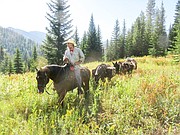Grizzly biologist’s personal account of reintroduction efforts in Gem State
Eric Barker | Hagadone News Network | UPDATED 5 years, 6 months AGO
Despite their size, cunning and fearsome reputation, there are a lot of things that can befall grizzly bears as they negotiate the perils of nature.
Likewise, there are myriad ways a multiagency effort to recover a threatened species can go off the rails.
In his new book “Journey of the Bitterroot Grizzly Bear,” retired Idaho Fish and Game biologist Steve Nadeau details both.
Nadeau, a bear of a man and a grizzly advocate, spent several years as a staff biologist at the agency’s Clearwater Region in Lewiston. His book tells the tale of a young grizzly in the Selkirk Mountains of northern Idaho that eventually makes its way south into the Bitterroots and the wildlife history books. It was the first grizzly in decades known to inhabit the area identified by wildlife professionals as a potential grizzly recovery area.
Nadeau delivers an insider’s view of the 1990s and early 2000s effort that led to the reintroduction of grizzly bears into Idaho’s Selway-Bitterroot and Frank Church wilderness areas.
He weaves the real bear’s partially fictionalized saga in and out of his own history as a biologist working on the reintroduction effort.
The bear, known as BB, nearly met its end more than once during scrapes with wolves and other grizzlies. But in time it grew strong, powerful and confident. Likewise, the reintroduction effort and Nadeau himself would come up against political foes from within and outside of government.
“Journey of the Bitterroot Grizzly Bear” is self-published, but don’t let that steer you away. It’s a quality piece of work filled with fine writing and keen insights into bear biology, politics and human nature. The book is available on Nadeau’s website, stevenadeauauthor.com and through Barnes and Noble and Amazon.
————
Tribune Outdoors spoke with Nadeau, of Boise, who has closely followed recent confirmed sightings, pictures and tracks of grizzly bears in north central Idaho.
“It’s an exciting time for bear supporters, but at the same time it’s a little scary thinking about these bears working their way through a gauntlet to get into central Idaho, and once they get here we are not really prepared for them,” he said.
When the plan to plant grizzly bears into the area was finally killed, so too was a designation that reintroduced bears would fall under more flexible management known as the 10J rule of the Endangered Species Act.
In its place, and by default, the government chose a “natural recovery” plan, meaning it would allow bears to find the area on their own but wouldn’t help them to do so. Those bears are fully protected as a threatened species under the ESA.
Bear hunting is one area that concerns Nadeau. Idaho allows black bear hunters to use bait in the Clearwater Region. Bait can and has attracted grizzly bears, Nadeau’s BB among them. He believes if baiting is to be continued in the area, Fish and Game must do more to educate hunters so they don’t mistakenly shoot a grizzly.
Nadeau thinks state and federal agencies have an opportunity to head off bear baiting litigation by coming up with ways to better protect grizzlies.
Nadeau, who worked in Yellowstone and Glacier national parks before coming to Idaho, long ago became comfortable being in grizzly bear country. But he’s aware that fear of both the bears and the extra regulations that come with an endangered species is the most common reason people oppose recovery.
“That fear tends to wane the more time you spend in grizzly bear country,” he said. “Your senses become more attuned and alert, much like a hunter’s senses when they are out seeking game.”
As far as regulations, he said that is a hurdle that can be worked around as well.
• • •
Eric Barker may be contacted at [email protected] or at 208-848-2273.
ARTICLES BY ERIC BARKER
Donaldson: Lewiston schools to close
The Lewiston and Lapwai school districts made the sudden decision Sunday to close schools today as a precautionary measure aimed at slowing local spread of the coronavirus.
Groups want more time to comment on river plan
A little more than a week after the federal government unvieled its massive draft environmental impact statement on the Columbia River Hydropower System and its effects on salmon and steelhead, some interest groups are asking for more time to formulate their public comments and questioning if public hearings should be delayed because of the coronavirus outbreak.
Washington prepares to close schools
School superintendents in southeastern Washington scrambled Friday to scrape together emergency plans following the announcement from Gov. Jay Inslee that all public and private schools in the state will shut down by Tuesday and stay closed through April 24 in an effort to stem the spread of the coronavirus.



